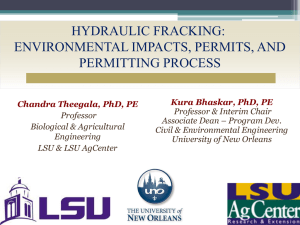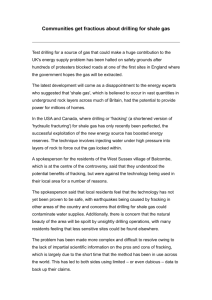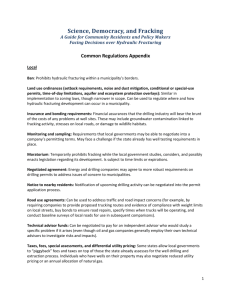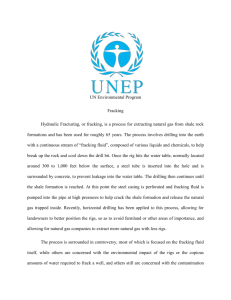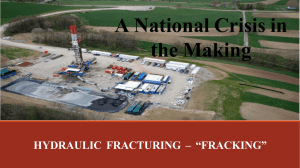hydraulic fracturing research paper
advertisement
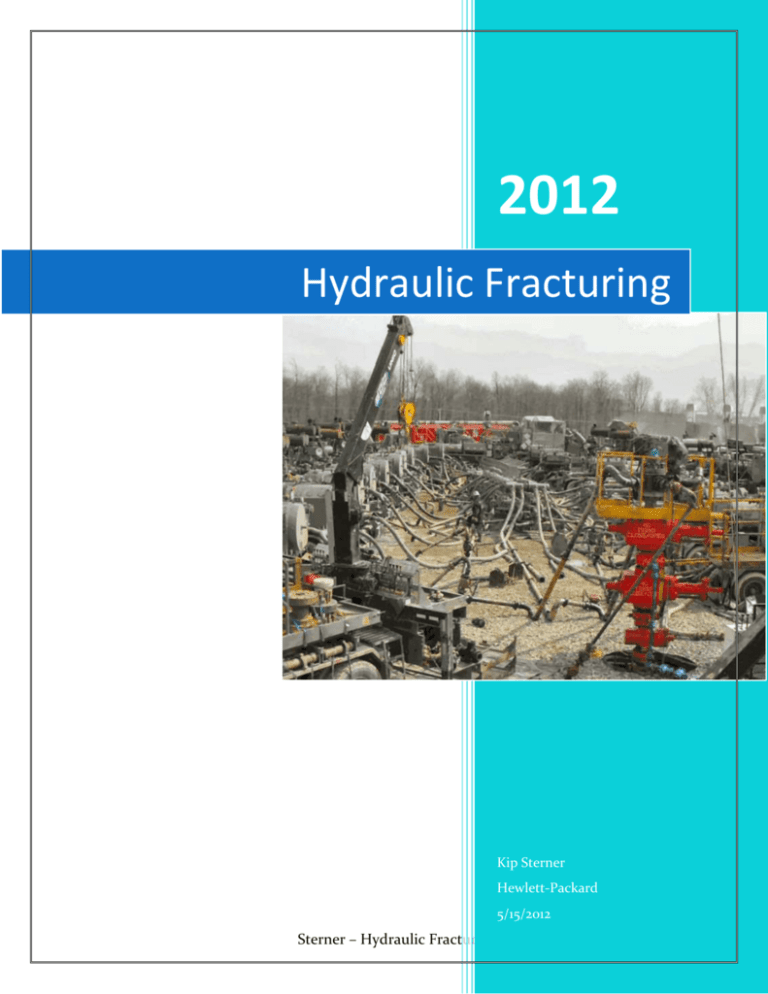
2012 Hydraulic Fracturing Kip Sterner Hewlett-Packard 5/15/2012 Sterner – Hydraulic Fracturing 1 One of the biggest issues in the world today is the problem of energy. Politicians, environmentalists, government officials, activists, corporations, and homeowners are all looking for ways to save money. Each energy source seems to have its own problems and benefits. Solar power, wind power, water generators, clean coal, and nuclear power are all on the table as possible solutions. However, the new trend is toward natural gas, and the way to get it is by horizontal hydraulic fracturing. Today with the search for more efficient ways to gather and refine energy, the "U.S. is in the midst of an energy revolution" (Akron Beacon Journal, "The Facts). With all the new searching for energy, different companies have looked into "fracking" as a process for collecting natural gas. But people are afraid of fracking. "The industry will have to take great drilling care.....a single serious example of water contamination could lead to a political panic. . ." (Akron Beacon Journal). An accident to water is not the only problem. This fracking method could cause stress on the planet with many ecological effects, because fracking is so new and has not been studied enough. The process of fracking seems to be the answer for a new and efficient energy, but its impact on water, air, and the earth, health, and property values indicates that actually fracking is a dangerous possible dangerous, possibly disastrous catastrophe. The oil and gas industry continues to spend money looking for fossil fuels. Some corporations are even still drilling for oil. As Jeremy Rifkin writes in The Third Industrial Revolution, “Drilling for more oil, however, won’t get us out off the crisis because oil is the crisis” (Rifkin, Jeremy). Therefore, in Ohio, the oil and gas industry has discovered that there is natural gas underneath the shale layer of rock at least a mile below the surface of the earth. They are developing ways with huge, powerful drilling machines and Sterner – Hydraulic Fracturing 2 chemicalized water to get at the gas. Because of Ohio's rock formations, this state is a key target for fracking companies--oil and gas companies that focus on continuing the search for fossil fuel. As many activists like to say, the new technology of hydraulic horizontal fracturing for natural gas (or "deviated drilling") is not the traditional, safer drilling seen all over Ohio. Anthony R. Ingraffea, a drilling expert, defines fracturing as "drilling vertically to the depth of about a mile and then horizontally about one to two miles" (Ingraffea, Video). To remove the shale gas, six to ten well heads are drilled on a well pad of about two acres, with at least eight more acres surrounding it. Each of these six wells receives 500,000 gallons of fresh water and 25,000 gallons of chemicals, which make the water "slick" in order to better drive it for such a long distance through a four inch pipe. The water blasts into the shale layer of rock and cracks it in thousands of places. As the water is withdrawn, the methane gas trickles into the spaces left behind. Then huge compressors on top of the earth suck out the gas, where it needs further treatment to be useable. (Greer, Mary, Interview). Each of the six wells requires about 1300 truck trips to bring in the water, and 1300 truck trips to remove the water, called "flow back fluids," chemicalized water that cannot be treated (Greer). Most of this flow back fluid is left in ponds to evaporate, dumped into creeks secretly, or injected into abandoned wells called injection wells (Ingraffea, Greer). New to this kind of drilling are the huge distances that the water must be forced, the huge compressor power to drive millions of gallons such a long way, and the possible 700 chemicals used that the industry does not have to disclose to anyone (Ingraffea, Greer). Sterner – Hydraulic Fracturing 3 The negative consequences of fracking on water resources are enormous. “Hydraulic fracturing fluids contain dozens of toxic chemicals like formaldehyde, benzene, toluene, biocides, etheneglycol, and hydrochloric acid, chemicals which have known adverse health effects and which are being injected through and near aquifers used for drinking water” (Finkel). These toxins being pressurized into the ground near aquifers can leak into the water and cause massive outbreaks of sickness and even death if ingested. Second, chemicals underground can move. In an article from a Santa Fe, New Mexico, source, one expert said that “What I’m concerned about with fracking is whether it might create a systemic path that allows methane to move vertically, even in a good well” (Matlock, Staci). Since chemicals travel, there can be no guarantees that any well is safe. In addition, some of the materials brought up are actually radioactive. Finkel writes that “Radioactive hazardous waste needs . . . special disposal sites” (Finkel). Since dumping these wastes is a common practice, these wastes can seep into the ground and access water pathways. This can contaminate natural springs, cause fish kills in lakes, and make streams dead zones. Another aspect of water contamination by fracking is the political problem of the EPA Safe Drinking Water Act. The EPA report on fracking has called fracking “unsound” and yet because of it, fracking fluids are “exempted from the Safe Drinking Water Act” (Matlock). The laws that we have about not dumping materials into lakes, streams, and rivers should protect us. However, the fracturing companies are allowed to dump all these hazardous materials and somehow, the law does not apply to them so they are not restricted from these dumping practices. Sandra Steingraber, a Ph.D. scholar at Ithaca College in New York testified that “this is a topic of urgent concern” (Steingraber Assembly Testimony). The reason this is a concern is that animals need water, people are 80% water, Sterner – Hydraulic Fracturing 4 and the entire environment needs water to survive. With contaminated waters, there will be destruction of all life. Fracking not only harms water but air as well. Steingraber testified before the New York State Assembly Standing Committee on Environmental Conservation and Health that “air pollution is an inevitable consequence of horizontal hydrofracking. Compromised air quality is a certainty” (Steingraber). She added that “77,000 wells are envisioned for New York State alone. Each well requires 1000 truck trips . . . a prodigious amount of diesel exhaust” will be put into the air (Steingraber). In other words, air quality will definitely be affected. She said that “. . . the wellheads themselves vent volatile organic chemicals . . . this kind of pollution is lethal. . . In adults, these pollutants are variously linked to bladder, lung, and breast cancer, stroke, diabetes, and premature death” (Steingraber). It is obvious that toxins in air are causing illnesses. Steingraber’s predictions turn out to be true when people around the country report their experiences when they live near fracturing. For example, Senator Case, Jr. of Pennsylvania wrote the Environmental Protection Agency requesting illness “clusters” in Pennsylvania as there is a “high risk of cancer for people living close to major facilities” (Lustgarten and Kusnetz). Like many in Pennsylvania today, he is well aware of the negative effects of fracturing. Nerve damage is another problem. “In Pavilion, Wyoming . . . residents have complained of nerve damage and loss of sense of taste and smell . . . 94%. . . complained of (drilling-related) health issues. . .19 families (were advised) not to drink their water” (Lustgarten and Kusnetz). These examples prove that the air pollutants from fracking can cause loss of senses and other problems. Another incident of polluted air by fracturing wells was reported in 2005 in western Colorado. A woman walked into her Sterner – Hydraulic Fracturing 5 neighbor’s field and fell down unconscious. Later it was discovered that fumes from a gas well had accumulated. The woman was violently sick, had rashes, and was ill for weeks. Air sampled at her property had fifteen contaminants above federal safe levels with known carcinogens like benzene, tetrachloroethene, and 1,4 dichlorobenzene (Lustgarten and Kusnetz). In another instance, a resident stated that he drove through clouds of toxic gas with burning eyes and an acid taste (Trumpener, Betsy). Such air problems affect everyone and everything in their path. Even in Canada, people are reporting illness. “Shale gas boom making us sick, say B.C. residents” was a headline on the CBC news, September 28, 2011 (Trumpener, Betsy). “. . . several farmers who live near gas fields . . . fear the boom is making them sick. . . Wilma Avery says her lungs were damaged when one company flared its wells and gas plant. . . ‘It’s a yellow pall that is completely around me’” (Trumpener). This pollution emission into the air from fracturing can and has caused health problems and will continue if not stopped. Fracking chemicals affect health through air emissions, but growth and development are at risk and no one knows when effects will emerge. Finkel reported that “One study. . . assessed the chemicals used in fracturing and found that 73% of the products had between six and fourteen adverse health effects. . . some. . . appeared fairly immediately . . . whereas others appeared. . . months or years later” (Finkel). This time lapse suggests that the chemicals cause problems at different times. These effects can occur in “lungs, kidneys, blood, and brain” (Finkel). Especially frightening is the effect on growth and hormones. “Of concern is that endocrine disrupting chemicals may alter developmental pathways . . . because of the lack of disclosure by the drilling companies. . .it is difficult to Sterner – Hydraulic Fracturing 6 truly assess their potential adverse effects. . .” (Finkel). These problems can affect everyone and throw off their chemical balance in ways of growth and ability to live a normal life. Finally, fracking destroys property values. Here are some aspects of land property and animals that may be affected: trees, lawns, private wells, creeks, road damage from hauling, fields made infertile from drainage, pets, farm animals and wildlife drinking from salts in flowback ponds (un-naturalgas.org). All these things are just a few of the concerns of what fracking can harm or even destroy. Everyone has known that companies that do fracking are known for paying benefits to landowners to drill on their land, but no one really thinks about the consequences of drilling has on their land. “The prospect of a one-time lease signing bonus can be tempting as can the promises made by landmen of future royalty payments once the oil/gas well is in production. However, potential . . . signers need to factor in… what it will do to their land” (Finkel). This proves that even though the “outcome” looks pleasing, no one takes in to consideration harms or destruction will occur to the land they own and will pass on to the next generation. In summary, fracking is a technology that requires thousands and thousands of truck trips, millions of gallons of water and chemicals, and thousands of acres of well pad access. The chemicals are toxic and move underground as well as on the surface to contaminate aquifers and surface waters. Dumping the waste water is an additional hazard. Air quality too in poisoned by exhausts. Reports of illnesses are all over the news. The affects on children may be hormonal imbalances that will cause problems the rest of their lives. Finally, this type of drilling reduces property values at a time when the housing market is hurting the most. Sterner – Hydraulic Fracturing 7 In conclusion, what should the United States do about finding new energy sources? So far alternative energies certainly couldn’t do everything we need to do for our everyday lives. Jeremy Rifkin asks, “What about coal in China, tar sands in Canada, heavy oil in Venezuela, and shale gas in the United States? While still relatively abundant, these energy sources are costly to extract and emit far more carbon dioxide than either crude oil or conventional natural gas” (Rifkin). Shale gas obtained from fracking is not the answer to energy and instead is a serious threat to people, animals, and every aspect of the environment. Sterner – Hydraulic Fracturing 8 References “Docu,emt the Condition of Your Assets before Drilling (or Seismic Testing) begins.” Info-sheet. <http://www.un-naturalgas.org > Doe, John. “Santa Fe Has Mortgage Problem.” Santa Fe Reporter. 10 Sept. 2011. <http://www.santafereporternewspaper.com>. Web article Finkel, Madelon L. “The Rush to Drill for Natural Gas: A Public Health Cautionary Tale.” American Journal of Public Health. Vol. 101. Issue 5. Pop. 784-785. May, 2011. Greer, Mary, Activist, Concerned Citizens Ohio Group. Personal Interview. 27 October, 2011. Ingraffea, Anthony R. #10 “The Effects of Shale Gas Drilling.” DVD Matlock, Staci. “Mora Country’s group’s water study provides first line defence against fracking.” 9 jan. 2011 <http://www.sanafemexico.com/Local%20News/First-line-ofdefence-against-fracking>. Web Lustgarten, A,. Kusnetz, N. “Science Lags as Health Problems Emerge Near Gas Fields. “ Pro Pulica. Sept. 16, 2011 <http://www.propublica.org/artical/science-lags-ashealth-problems-emerge-near-gas-fields>. web Rifkin, Jeremy. The Third Industrial Revolution: How Lateral Power Is Transforming Energy, the Economy, and the World. ,New York: Palgrave-Macmillan, 2011. Book. “The Facts About Fracking.” Akron Beacon Journal. Saterday/Sunday, June 25-26 2011. Trumpener, Betsy. “Shale gas boom making us sick, says B.C. residents.” CBHC News, Sept. 28, 2011 <http://www.cbc.ca/news/canada/britishcolumbia/story/2011/09/28/bc-shale-gas-farmers.html> web Sterner – Hydraulic Fracturing 9 “What the Frack!!!!” “An Educational Forum on Safe Drinking Water and Gas and Oil Drilling.” Sponsors: Kent Environmental Counci;, Allegheny Energy Solutions, Concerned Citizens for Safer Drilling. Sterner – Hydraulic Fracturing

